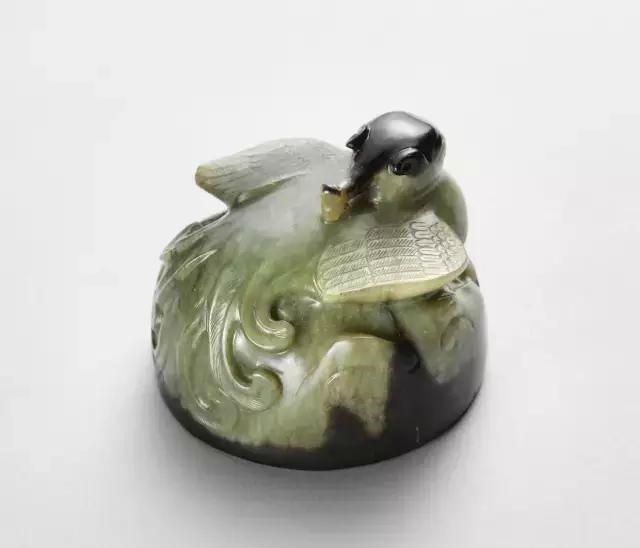An exceptionally rare jade mythical-bird scroll weight, Eastern Han Dynasty or later, four-character dehui yunri mark, 18th ct
Lot 54. An exceptionally rare jade mythical-bird scroll weight, Eastern Han Dynasty or later, four-character dehui yunri mark, 18th century, 6.5cm (2 1/2in) diam. Estimate HK$800,000 - 1,200,000 (US$100,000 - 150,000). Sold for HK$ 2,340,000 (€268,919). Photo: Bonhams
The domed scroll weight masterfully carved as a mythical bird with a single horn and pointed beak, surmounting a circular base with its wings outstretched as if ready for flight, the slightly flared wings flanking a bulbous body, the six grooved long tail feathers elegantly curled in various directions, all meticulously incised with a well-defined feather pattern rendering a vivid movement, the interior of the base hollowed and incised with a later added four-character 'dehui yunri' inscription encircled by a band of incised cloud scrolls, the smoothly polished stone of greenish-yellow tone suffused with russet and black inclusions.
Provenance: Acquired in Hong Kong in 1998
The Songzhutang collection, no.74
Published and Illustrated: T.Fok, The Splendour of Jade: The Songzhutang Collection of Jade, Hong Kong, 2011, pl.74
Note: The present lot is an outstanding and important example of an early jade carving which represents the pinnacle of Han dynasty jade craftsmanship. This rhythmically carved bird is remarkable for its intricate relief decoration in various depths and its finely incised details on the feathers, exhibiting the carver's exceptional technique in producing a naturalistic and dynamic three-dimensional jade animal.
During the Han dynasty, weights of this type are believed to have been used by the Imperial family and high nobility to place on mats lining the floor, which were used for sitting at the time. These were often weighted at the corners with gilt-bronze weights, or more exceptionally, prized jade carvings. These kind of weights were usually made in the shape of animals or human figures, and would have been made in sets of four. The present lot would have been associated with the animals of 'the four directions': the green dragon (East), the white tiger (West), the dark tortoise encircled by a snake (North) and the red bird or phoenix (South) as in the present lot; so the four directions symbolised the entire world. Being at the centre surrounded by the animals of the Four Directions conveyed a high social status and power of the person, suggesting the possibility that the present lot once belonged to a member of the Imperial family or a high ranking noble.
Compare a bronze weight in the form of a mythical bird, Han dynasty, in the National Palace Museum, Taipei (museum no.000333N). Although the craftsmanship of this bronze weight is less detailed, the bird is similarly depicted perched on a circular base, with a bulbous body, a pointed beak and a single horn. Also compare the modelling of Han dynasty jade carvings of turtle doves, which were typically used as staff pommels, in the National Palace Museum, Taipei; similarly depicted with a single horn and long tail feathers, illustrated in Art in Quest of Heaven and Truth: Chinese Jades through the Ages, Taipei, 2011, nos.3-3-36 and 5-4-7.
Xiqing gujian 西清古鑑 (A catalogue of ancient ritual bronzes in the collection of the Qianlong emperor), vol.38, p.46
The present lot is closely related to a line drawing of a bronze weight in the shape of a mythical-bird, Han dynasty, published in Xiqing gujian 西清古鑑 (A catalogue of ancient ritual bronzes in the collection of the Qianlong Emperor), vol.38, p.46. The Qianlong emperor instructed the Court to collect drawings of antiquities, which served as sources of designs for the production of contemporary vessels, in order to reinstate the intrinsic qualities of simplicity, sincerity and happy exuberance of the ancient cultures; see Chang Li-tuan, The Refined Taste of the Emperor: Special Exhibition of Archaic and Pictorial Jades of the Ch'ing Court, Taipei, 1997, pp.49-50. The line drawing of the mythical bird shows close similarities to the present jade weight including the overall shape of the object, the depiction of the curling long tail feathers, as well as the wings and tail feathers portrayed in dense and detailed lines.
The auspicious inscription incised on the underside of the present lot, 'Dehui yunri' 德輝雲日, meaning 'Virtue is as broad as the sky', indeed reflects the Qianlong emperor's aspirations. The execution of the four characters on the present lot is typical of the fluid and elegant style of the Qianlong period jade seal-script inscriptions.
According to Shuowen Jiezi 說文解子, a Chinese dictionary written by the Eastern Han dynasty scholar Xu Shen, jade symbolises the five virtues of humanity: benevolence, integrity, intelligence, bravery and honesty. The Qianlong emperor regularly oversaw the entire process of jade production to ensure that the finished pieces met his standards of purpose and beauty; he also composed more than eight-hundred poems and essays about jade, demonstrating the importance of this prized and symbolic material to the emperor.
Bonhams. THE SONGZHUTANG COLLECTION OF EARLY JADES from the Neolithic Period to the Yuan Dynasty, 30 May 2017, 14:00 HKT

/https%3A%2F%2Fprofilepics.canalblog.com%2Fprofilepics%2F1%2F0%2F100183.jpg)
/https%3A%2F%2Fstorage.canalblog.com%2F03%2F02%2F119589%2F96711876_o.jpg)
/https%3A%2F%2Fstorage.canalblog.com%2F11%2F31%2F119589%2F94773502_o.jpg)
/https%3A%2F%2Fstorage.canalblog.com%2F20%2F83%2F119589%2F94772815_o.jpg)
/https%3A%2F%2Fstorage.canalblog.com%2F26%2F72%2F119589%2F75604929_o.jpg)
/https%3A%2F%2Fstorage.canalblog.com%2F59%2F60%2F119589%2F26458628_o.jpg)








/image%2F1371349%2F20240406%2Fob_de099f_435265592-1644340289669317-27147449708.jpg)
/image%2F1371349%2F20240310%2Fob_c0e13b_431753965-1629270041176342-17091014609.jpg)
/image%2F1371349%2F20240229%2Fob_7c7d11_428701194-1625292201574126-44092414790.jpg)
/image%2F1371349%2F20240229%2Fob_b5ac39_428703110-1625267244909955-59751988979.jpg)